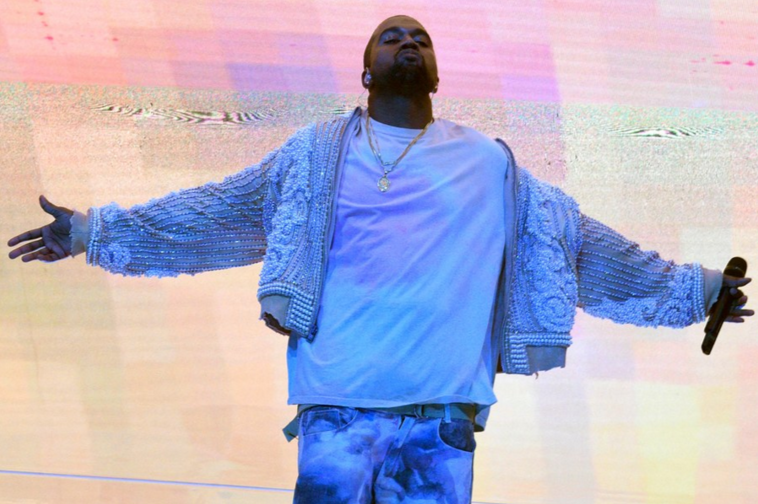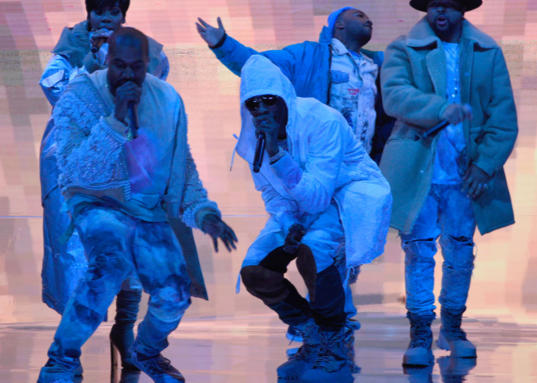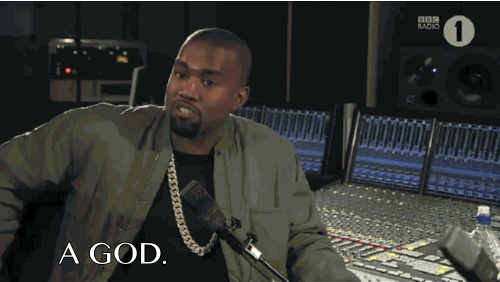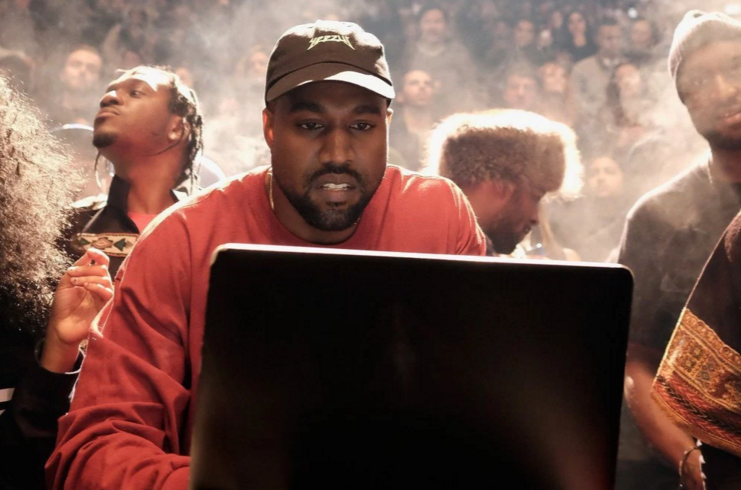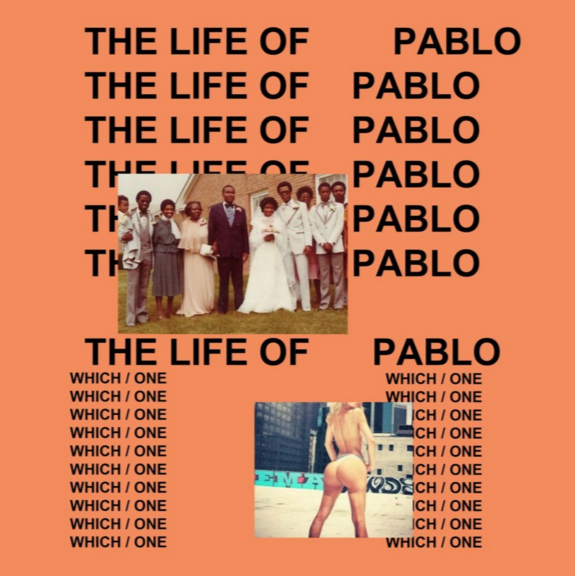During a late night performance that would bleed into Valentine’s Day, Kanye West stood upon the Saturday Night Live stage for the seventh time, previewing “Highlights” and “Ultralight Beam” from his recently released album, The Life of Pablo. From beneath the impossibly vertical scroll of a pixelated sky, the brief showcase was exuberant, angelic even, and it was finally apparent why Kanye had described the project as “actually a Gospel album” a few weeks prior to the release.
Adorned in whites and soft blues, not only did the performance feature contributions from stars like Young Thug and Chance The Rapper, it also rested squarely on supporting vocals from over a dozen choir members. For a few select moments, there was a subdued power behind the performance. An almost restrained Kanye seemed to channel his older affiliations with the church, letting the combined power of his backing vocalists overtake the performance. This was just moments after Kanye had “freaked out” backstage over an altered stage, but that wouldn’t leak until a few days later. By the end of the set he was back to his more pronounced self, skittering across the stage and directing his nationwide audience to kanyewest.com and TIDAL in between hurried breaths.
Regardless of what you thought of the performance, the anticipation itself was inarguable. Twitter lit up instantly as viewers from around the world began to scour the Internet for the release, only to find that Kanye’s website still displayed the same plea from Yasiin Bey that it had for weeks, and that TIDAL streaming was only accepting payments for the album in sporadic doses, ill-equipped to absorb the onslaught of traffic it had never experienced before. Even within a perpetually saturated rap-landscape it’s tough to remember when such anticipation for a single release was felt in unison. If rappers truly are the new rockstars, Kanye is right when he unapologetically proclaims: the biggest of them all.
Of course, we’ve heard of the hybrid rapper-rockstar comparison before. Parallel lifestyle imperatives of endless excess and hubris are celebrated regularly across both music cultures. In 2013, Kanye West famously proclaimed, “We the real rockstars!” in an impassioned interview with Zane Lowe on BBC Radio 1. He went on to detail how rappers are today’s most important pop icons, and from behind a glittering bottom row of diamond teeth, it was tough to argue otherwise. By many accounts, ‘Ye is still accurate to this day: Hip Hop is now the most consumed genre of music in the world, according to an analysis of over 20 billion Spotify streams completed in 2015. In the face of those types of numbers, it’s no wonder why a fledgling streaming service like TIDAL struggled to keep up with user-demand on a release like The Life of Pablo.
Combine the streaming statistics of Spotify’s industry-leading 75 million users with rap music’s Twitter dominance, and you have a strong case for Hip Hop’s standing as the most ubiquitous genre in the world right now. That’s a long way to come from early percussive breaks and dance battles in the 1970s Bronx, Hip Hop’s birthplace. The genre is now a multi-billion-dollar industry that breathes life into global culture itself, blossoming into unthinkably vast and pervasive territory in just a handful of decades. And as we usher in the new year of music’s mainstream trends, stories like Kanye’s pop-culture dominance are just the newest iterations of a seemingly unstoppable torrent. While the world may be still yearning for more 6 God memes and Greatest Rapper Alive debates to rest adjacent to Kanye’s ubiquity, this pinnacle of popularity elicits fundamental questions about where rap music might be headed in 2016. The current elite rapper class is brimming with full-blown rock stars that are now practically considered to be new-age deities, and while the next wave of rappers attempts to supplant their predecessors, we can’t help but wonder if Hip Hop will move along its current ascent into the strata of super-culture, or if its astral projection has finally hit a peak.
While it’s clear the genre’s traveled light-years beyond its humble New York neighborhood beginnings, we can’t predict where such depths of mass exposure and appeal are leading the once raw art form. What does this nexus of mainstream prominence, commercialism and genuine artistic expression bode for a genre that has for so long been the voice for the oppressed and underrepresented? While Hip Hop culture grew first as an artistic expression of urban American life, you’d be hard-pressed to find anyone these days who can’t name a chart-topping rapper off the top of their heads or, at the very least, bust out a dab on national television (thanks for literally killing it, Hillary).
Now, as if descending from heaven instead of a dressing room, Hip Hop’s biggest rap icons are our generation’s living Gods: an embodiment of Karl Marx’s prophetic description, “the opiate of the masses.” The allure of the genre itself has endured the decades since its inception. And while as fans we can typically only dream of a life as opulent as described in its most anthemic songs, for the three-and a half minutes that the right rap record is spinning, we can actually live it too. Even 40 years after Hip Hop’s creation, the culture’s global appeal is so strong the regrettable issue of its ongoing appropriation doesn’t seem to be going anywhere anytime soon.
To understand how the modern hype over Hip Hop might impact the genre, we can look at the story arcs of other once massively popular music styles as a cautionary tale. Trends come and go. Disco, hair metal, grunge: all of these stylings began organically in earnest only to be consumed by mass culture, spit out and left for dead. Might Hip Hop go this way too or will its ethos live on regardless of the mainstream’s ADHD-driven proclivities? Will rap music fall by the wayside as new musical styles permeate the airwaves? Or perhaps this concern is a non-issue. Rather, some of today’s biggest rockstar-rappers are helping redefine the genre entirely, paving the road map for Hip Hop’s new age evolution much like the way rock music has been able to survive in its many textures: alternative, indie, punk, metal and blues to name a few.
But to know where we’re going, we’ve got to know where we’ve been. Long before Kanye was repeatedly dominating the SNL stage, Hip Hop was being thrust from the boroughs of New York City. Like many other art forms and cultural movements, Hip Hop began as an organic evolution of various influences and artists, driven chiefly by African-American and Latino communities in the 1970’s Bronx. In 1973, innovative turntablists like DJ Kool Herc began extending soul, funk and disco songs’ break beats—the portion of the record where the vocals and other melodies are dropped out—to focus on the percussion. This emphasis on a song’s driving rhythm encouraged crowd dancing and participation, and it was only a matter of time until the DJ style paved the way for percussion-heavy tracks providing the perfect background for spoken word. Thus, emceeing or rapping was born.
In the 1980’s, Hip Hop music with recorded raps began developing into more complex styles, as DJs and producers continuously tinkered with new tools and equipment, pushing the boundaries of the new soundscape. By the end of the decade, Hip Hop’s Golden Age had arrived, and it was as if every new single was reinventing the genre itself. The innovative use of drum machines for sampling became a bona fide staple of the genre, and as the music and production techniques became more intricate and explorative, so too did the rapping: focus on lyrical content, literary devices and fresh rhyming patterns became the new norm. This combination of eclectic styles and samples along with political and Afrocentric lyrical themes established the genre as an impassioned form of expression, as epitomized by acts like A Tribe Called Quest and De La Soul. Pronounced rebellion against oppressive forces and the tyranny of the majority became a dominating motif that still permeates throughout the genre today.
Through the 1990s, the mainstream populous began to take note of Hip Hop’s rebellious energy, attitude and allure, paving the way for success stories never before realized in the genre. Bold East Coast and West Coast rappers alike from Public Enemy to N.W.A were experiencing unprecedented success on a national level, and Hip Hop’s cultural significance could no longer be denied.
Even 28 years after Straight Outta Compton was originally released in 1988, it’s found its way into global consciousness as an Academy Award nominated biopic, grossing hundreds of millions of dollars. In a sense, Hip Hop’s ascent and modern day gloss can be attributed to this same type of transition. From “F*ck Tha Police”—one of the earliest Hip Hop songs to painstakingly detail police brutality—to a palatable blockbuster best viewed with buttery popcorn. Rap music’s role as an epicenter for expression and social commentary was asserted by major media as early as 1990:
“Rap is the rock ‘n’ roll of the day. Rock ‘n’ roll was about attitude, rebellion, a big beat, sex and, sometimes, social comment. If that’s what you’re looking for now, you’re going to find it here.”
— Bill Adler, TIME Magazine, 1990
The genre became a world phenomenon more rapidly than even its founders could have anticipated, and as its cultural impact increased, so too did the commercialization of the art form. Although the Hip Hop industry experienced a heavy decline in album sales in the 2000s, it’s resurgence has been both wide scale and profound. While the New York Times once wrote, “rappers may have to reconsider their place in the universe,” major artists have now embraced social media and digital streaming to further cement their place amid mainstream audiences. Future and Drake’s collaborative effort, “Jumpman” has already topped 157 million streams on Spotify, while newcomer Bryson Tiller’s debut album T R A P S O U L amassed 21 million streams in the first week of 2016 alone, with 35,000 hard copy sales to boot. Though rap music’s peak sales of the 1990’ were a boon for the industry, the genre’s modern online popularity and exposure continues to ensure packed shows and constant trending topics. And so the modern rap landscape is growing from fertile ground once again. OutKast’s “Hey Ya” boasts a clean radio-edit that still makes nostalgic fans bum-rush the dance floor, and new publishing and streaming deals from services like TIDAL make the business increasingly viable for select rap gods innovative enough to push their music into public consciousness.
Even while the genre transitions into new territory, it’s still arguably influenced by its past as much as ever. Rappers like Young Thug are channeling influences like jazz and scat into genre-defying Hip Hop spin-offs that shrug off Webster’s dictionary like dead weight. Then, there’s Kendrick Lamar, who blends mainstream appeal and soulful funk influences with the politically and socially charged more seamlessly than anyone across the genre. The similarly socially aware Roc Nation superstar J. Cole proved that rappers can grow genuine fan bases without help, becoming the first rapper in 25 years to go platinum without a single feature. Bucking the industry system completely, Chicago’s Chance the Rapper became the first unsigned artist to perform on Saturday Night Live in the history of the show. Meanwhile, artists like Travi$ Scott are still resisting the Hip Hop label entirely.
Some could argue Hip Hop by its original name is dead; nostalgic traditionalists that prefer Golden Era throwbacks or 90s boom-bap beats to synthesizer laden production and warbled speech. But from the moment we heard Kanye’s laser-inundated “On Sight,” the introduction to his 2013 album Yeezus, we were given a visionary attempt at evolving the genre. And a new post-Kanye class is now emerging who eschew classic Hip Hop sound aesthetics for modern, 808-heavy production and eclectic geographical influences. Take for example Lil Uzi Vert, Philadelphia’s newest rap star [currently featured in the February/March issue of The Source], who on HOT 97 recently refused to freestyle over a DJ Premier beat and instead demanded a modern soundscape to spit over, explaining he and his fans don’t like old Hip Hop. What track did he go for? Kanye’s “Robocop” off of 808s & Heartbreaks, a favorite and major influence for Vert. OG rap heads might have been outraged, but Uzi and other new artists like him represent an emerging class of rappers who draw inspiration in an internet age where influences are as vast and varied as cell-phone chirps and Marilyn Manson.
Going from 808s to Yeezus (however blasphemously branded) still gave us plenty to ponder in way of monotheism, capitalism and our understanding of rap culture, perhaps simultaneously testing the boundaries of rap sentiment and production more so than any other rap release of the decade. Is it any wonder why the roll-out supporting the perpetually re-branded The Life of Pablo was equally, if not more audacious than its predecessor? Such experimentation continues to inspire a myriad of effects throughout the genre, some more immediately noticeable than others. One might liken this to a sort of “trickle down” effect; whereas a landmark album inspires other feats of wild-eyed experimentation. Kid Cudi’s recent album, one of the final releases of 2015, is one of them. While Speedin’ Bullet 2 Heaven was largely panned, it’s unclear whether it was because fans and critics weren’t expecting the loosely inventive nature of the album, or because they were simply craving the more anthemic theme songs typically attributed to the artist. The album’s overall rock direction, hushed hooks and guitar strumming, not to mention an utter lack of rap bars, calls into question what it means for a project to be classified under the Hip Hop umbrella in the first place. Critical bust or not, experimentations like this continue to showcase how an artist can work both within and without the framework of established genre. And like it or not, Kanye’s brash claim as the world’s biggest rockstar continues to ring true as his artistic defiance continues to permeate the genre as a whole.
As traditionalists and newfound fans scramble to digest The Life of Pablo, only time will tell if the project will further break, or build, the foundation of the modern rap genre. Because if we’re lucky, rap music won’t just ascend neatly into 2016. It will move forward, yes, but sideways too. It will create, destroy, live and breathe as it’s meant to do. While the rap gods of our time are still climbing toward impossible heights, the fate of the genre continues to evolve into something far greater than the sum of its parts. Something that even the best hook can’t quite describe.
Additional Reporting: Joe Pitts
